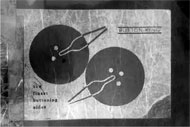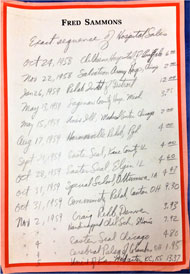Documenting Assistive Technology History: The Fred Sammons Archive Project Resource
Caitlin G. Dobson, B.A.
Kathryn E. Koch, B.S.
Roger O. Smith, PhD, OT FAOTA, RESNA Fellow
INTRODUCTION
Fred Sammons is a figure well-known within the assistive technology (AT) and occupational therapy community (OT). His career helped orient the course of the AT and OT fields. Beginning as an industrial arts teacher and later becoming a clinician, he worked in prosthetics research and development, AT invention and marketing, and the creation of a successful multimillion dollar company that has now spanned decades. His products have been instrumental in rehabilitation, and continue to be tested in modern clinical research studies as well as in clinical practice (“Product,” 2016). He has actively served in interdisciplinary professional associations including AOTF, AOTA, and RESNA.
Fred Sammons began his career as an occupational therapist in 1955 after having worked extensively with technology on his family’s farm, studying to be an industrial arts teacher, and serving in the Army as a chemical researcher and on a Great Lakes iron ore ship. His company originated as a one-man mail-order operation called Button-King, which Fred Sammons ran in his spare time, continually expanded rapidly and eventually grew to having been acquired and resold several times..
Archiving Sammons’ personal and business artifacts which span from his early life to the present through the Fred Sammons Archive Project at the University of Wisconsin-Milwaukee (UWM) creates research and educational opportunities for OT students and practitioners.
OBJECTIVE
Accumulate and Archive Artifacts
Fred Sammons’ archival materials include a variety of personal belongings that he has saved throughout the years. Business documents and personal information add depth to the archives as a research tool with historical, technological, and economic value. The Fred Sammons Archive Project at UW-Milwaukee contains both physical and digitized references for students, educators, and practitioners to reference.
Full Historical Scope of Button-King and Beyond

The archives also contain assistive devices sold by Fred Sammons in his catalogs, and prototypes of assistive devices that Sammons created himself. Autobiographical materials are also included, such as photographs, sketchbooks, letters, and personal items that shed light on Sammons’ personal life and the qualities that propelled his success and innovation in the field.
Researchers are working with the University of Wisconsin-Milwaukee Golda Meir Library to enable full public access through their archival operations.
METHODS
Interviews and autobiographical information
The Fred Sammons Archive Project at University of Wisconsin-Milwaukee includes video-recorded interviews between Sammons and Professor Roger O. Smith, in which Sammons discusses his career and impactful events within his life. The videos contain explanations of the relevance of many of the more impactful physical archived artifacts. In addition, Sammons recounts events that shaped the field of OT and AT, his career, his life in general, and the historical context surrounding the development of the OT and AT education and practice.
Website

|
||||||||||||||||||||||||||||||||||||||||||||
Artifacts were donated to the university by Fred Sammons and consisted of a wide range of media types (“Reknown,” 2015). Catalogs were sorted by name of publication (i.e., “Be-OK!” or “Enrichments”) and date of publication. Other paper documents like pricing sheets, business expense reports, legal documents, business correspondence, and personal correspondences were sorted by date and subject matter. Photographs were stored in folders by estimated date range. Post-cards, signs, newspaper clippings, business cards, certificates, assistive devices, report cards, yearbooks, audio tapes, video tapes, and other assorted, unique belongings were sorted into folders or envelopes if possible and put into boxes. If there were accompanying photographs, letters, or other paper documents, these were put into the same box.
Videos were recorded in four interview sessions, with a fifth session pending. Video sessions required the coordination of the UW-Milwaukee Video & Multimedia Production Department. Artifacts were transported to the film studio on campus. Professor Roger O. Smith engaged Sammons in one-on-one, unscripted questions that centered primarily around the artifacts and the historical events in Sammons’ life. Four video filming crew staff members were responsible for video and sound quality.
RESULTS
Research Questions… |
What is the relationship between intellectual property and AT product development? |
What makes an AT device commercially successful? |
How do cost, quality, and need for product relate? |
How do new materials change the course of product development? |
What motivates hopeful inventors of AT? |
How did low-tech AT change the OT profession? |
What are various ways to enter the field of OT and how did this change historically? |
What is the relationship of AT funding to product availability? |
How did laws around health care shape the development of AT and the OT profession? |
Artifacts and interviews
The Fred Sammons Archive Project revealed artifacts that dated from the early 1900s through the 2000s. Hundreds of catalogs, video and audio cassette tapes, sketchbooks, artwork, several hundred photographs, assistive devices, and thousands of pages of business records and personal materials are included in the archives.
The individual video recorded interview sessions’ unedited run time was recorded as follows: 1:22:18, 1:32:48, 1:56:48, and 1:23:58, coming to a total of 6:15:52. Each session was broken into clips based upon content. Each clip was, on average, less than five minutes in total length, with between 20 and 40 clips per video. Video segments were coded according the day they were recorded, starting time, ending time, total length, qualitative descriptions and keywords, which artifacts if any were featured in the video, and where these artifacts would be physically located in the archives.
User interface and public access
The interface of the Fred Sammons Archive Project website follows principles of universal design in its development. The videos and website are intended to be useable by persons with disabilities. Equivalent text descriptions are available for images on the website. Closed-captioning can be made available for video files. The website will feature a user-friendly interface with adjustable font sizes and high contrast. Sans serif fonts and large buttons.
The Fred Sammons Archive Project website is intended to be a publicly used database resource for health service communities, educational institutions, and the general public in order to widely share knowledge of OT and AT and Sammons’ influence upon them. The website will be free to users. Additionally, segmented video clips and full video sessions will be available through YouTube.
DISCUSSION
One of the great advantages of the Fred Sammons Archive Project is the depth of the materials included and breadth of questions that can be answered by the database. Key findings of the archives project possibilities for the future:
1) Educators, students, and clinicians have insight into Sammons’ methods as a clinician, researcher, and AT developer.
2) Historians concerned with OT and AT evolution will find a wealth of knowledge within not only the prototyped devices contained in the archives, but will also find information contained within the hundreds of Sammons’ business catalogs and local newspaper articles showcasing how new devices were being used to improve the quality of life of patients within the community.
3) Those concerned with entrepreneurialship will find valuable information within the video recorded interviews, catalogs, expense reports, and correspondences. Sammons himself never patented a product; thus, the importance of intellectual property rights within the context of product development and dissemination can be examined through a case-study of Sammons’ interviews and records of his sales.
REFERENCES
(F. Sammons, personal communication, 1968-1959.)
Patterson Medical. (2016). Retrieved February 17, 2016, from http://www.pattersonmedical.com/
Product Search Results. (2016). Retrieved February 17, 2016, from http://www.pattersonmedical.com/app.aspx?cmd=searchResults
Renowned OT pioneer Fred Sammons donates collection to UW-Milwaukee Archives. (2015). Retrieved February 17, 2016, from http://uwm.edu/healthsciences/news/renowned-ot-pioneer-fred-sammons-donates-collection-to-uw-milwaukee-archives/